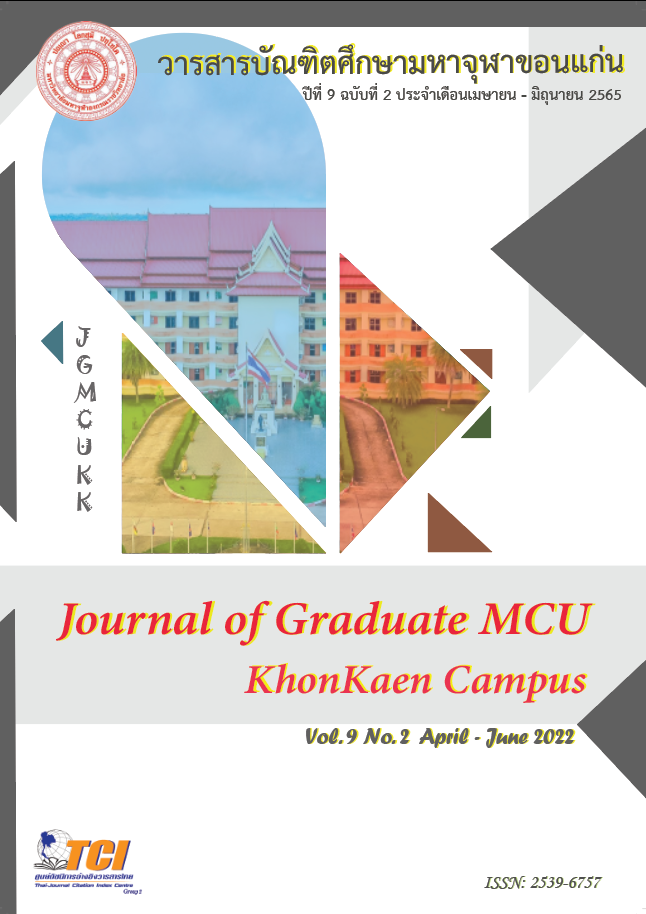การพัฒนาผลสัมฤทธิ์การเรียนรู้คำศัพท์ภาษาอังกฤษ โดยการจัดการเรียนการสอน แบบผสมผสานสำหรับนักเรียนชั้นประถมศึกษาปีที่ 6 การพัฒนาผลสัมฤทธิ์การเรียนรู้คำศัพท์ภาษาอังกฤษ โดยการจัดการเรียนการสอน แบบผสมผสานสำหรับนักเรียนชั้นประถมศึกษาปีที่ 6
Main Article Content
บทคัดย่อ
การวิจัยครั้งนี้มีวัตถุประสงค์เพื่อ 1) พัฒนาผลสัมฤทธิ์การเรียนรู้ด้านคำศัพท์ของนักเรียนหลังการเรียน และ 2) พัฒนาความพึงพอใจการเรียนรู้ด้านคำศัพท์ภาษาอังกฤษโดยการจัดการเรียนการสอนแบบผสมผสาน เครื่องมือที่ใช้ในการวิจัย ได้แก่ 1) แผนการจัดการเรียนรู้คำศัพท์ที่สอนโดยการจัดการเรียนการสอนแบบผสมผสาน 2) แบบทดสอบวัดผลสัมฤทธิ์ทางการเรียนรู้คำศัพท์ภาษาอังกฤษสำหรับนักเรียนชั้นประถมศึกษาปีที่ 6 สังกัดกรุงเทพมหานคร 3) แบบสอบถามความพึงพอใจที่มีต่อการเรียนรู้คำศัพท์ภาษาอังกฤษโดยการจัดการเรียนการสอนแบบผสมผสาน สถิติที่ใช้ในการวิเคราะห์ข้อมูลได้แก่ ค่าเฉลี่ย ส่วนเบี่ยงเบนมาตรฐาน การทดสอบค่าที (t-test) แบบ Dependent Samples และ
การเปรียบเทียบขนาดอิทธิพล ผลการวิจัยพบว่า 1) นักเรียนมีผลสัมฤทธิ์ทางการเรียนคำศัพท์ภาษาอังกฤษหลังเรียนสูงกว่าก่อนเรียน อย่างมีนัยสำคัญทางสถิติที่ระดับ .05 2) ความพึงพอใจของนักเรียนอยู่ในระดับมากที่สุดมีค่าเฉลี่ย 4.51 การเปรียบเทียบขนาดอิทธิพล พบว่าค่าขนาดอิทธิพลของการทดลองเท่ากับ 2.110 (Cohen’s d = 2.110) แสดงว่าผลสัมฤทธิ์ทางการเรียนหลังเรียนหลังเรียนสูงกว่าก่อนเรียนอยู่ในระดับมาก (Large effect size)
Article Details

อนุญาตภายใต้เงื่อนไข Creative Commons Attribution-NonCommercial-NoDerivatives 4.0 International License.
เอกสารอ้างอิง
กระทรวงศึกษาธิการ. (2551). ตัวชี้วัดและสาระการเรียนรู้แกนกลาง กลุ่มสาระการเรียนรู้ภาษาต่างประเทศ. กรุงเทพฯ: โรงพิมพ์ชุมนุมสหกรณ์การเกษตรแห่งประเทศไทย.
กรมวิชาการ. (2544). หลักสูตรการศึกษาขั้นพื้นฐานพุทธศักราช 2551. (ฉบับปรับปรุง พ.ศ. 2560). กรุงเทพฯ: โรงพิมพ์องค์การรับส่งสินค้าและพัสดุภัณฑ์ (ร.ส.พ.).
บุญญาธิดา ท้วมจันทร์. (2564). การพัฒนาชุดกิจกรรมการเรียนรู้แบบผสมผสานเชิงรุกโดยใช้บริบทท้องถิ่นเป็นฐานวิชาภาษาอังกฤษสำหรับนักเรียนชั้นประถมศึกษาปีที่ 6 ที่เน้นการสื่อสารเพื่อเตรียมความพร้อมสู่เขตเศรษฐกิจพิเศษเชียงราย. วารสารคุรุสภาวิทยาจารย์, 2(1), 27-37.
ปริยาภรณ์ บุญมีรอด, และเอกนฤน บางท่าไม้. (2561). การพัฒนากิจกรรมการเรียนการสอนแบบผสมผสานร่วมกับการเรียนแบบแก้ปัญหาเชิงสร้างสรรค์
เพื่อพัฒนาผลงานการถ่ายภาพเชิงสร้างสรรค์ของนักศึกษาระดับปริญญาตรี. (วิทยานิพนธ์ศึกษาศาสตรมหาบัณฑิต). กรุงเทพฯ: มหาวิทยาลัยศิลปากร.
พัฒนะ พิพัฒน์ศรี. (2563). การพัฒนาการจัดการเรียนรู้แบบผสมผสาน เรื่อง การเขียนโปรแกรม KidBright สำหรับนักเรียนชั้นมัธยมศึกษาปีที่ 3. (วิทยานิพนธ์การศึกษามหาบัณฑิต). ชลบุรี: มหาวิทยาลัยบูรพา.
Alan Robert, White. (2019). A Social Media Based Learning System: An Investigation on the Use of the Line Application for Teaching and Learning English Vocabulary and Grammar at a Thai Public University. Journal of Social Science and Humanities Research in Asia, Assumption University, 25(3). 3-4.
Amaal Al, Masri. (2020). The effectiveness of using blended learning for teaching English language vocabulary for 1st grade students at Al Tafila Directorate of Education. International Scholars Journals, 8(8), 001-006.
Atmowardoyo, H., Weda, S., & Sakkir, G. (2020). Information Technology used by Millennial Good English Language Learners in an Indonesian University to Improve their English Skills. Solid State Technology, 63(5), 9532-9547.
Lim, D. H., Morris, L. M., & Kupritz, W. V. (2007). Online vs Blended Learning: Difference in Instructional Outcomes and Learner Satisfaction. Journal of Asynchronous Learning Networks, 11(2), 38-50.
Sakkir, G. (2016). Interest and Writing Skill of the University Students on Using Social Media-Facebook in Writing Class (STKIP Muhammadiyah Rappang, Indonesia). In Asian EFL Journal (Second Language Acquisition-Academic Research) TESOL
Indonesia International Conference Edition, 2, 178-188.

